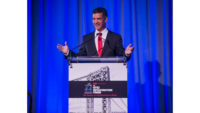Crews with Judlau Contracting in joint venture with TC Electric on April 26 completed—at least three months early—a $477-million contract to rehabilitate the Superstorm Sandy-damaged Canarsie Tunnel carrying the L subway line between Manhattan and Brooklyn. The work, begun in April last year, incorporated key ideas from academia, including fiber-reinforced polymers (FRP) and new cabling.
The original plan by the New York Metropolitan Transportation Authority (MTA) had been to shut down the heavily-used L line for 18 months starting in April 2019, but four months earlier, Gov. Andrew Cuomo (D) officially scrapped that plan and called on engineering professors from Columbia University and Cornell University to brainstorm an alternative.
Lance Collins, dean of engineering at Cornell, says the governor had reached out to academia in December 2018. “We spent the better part of a month brainstorming and making a set of recommendations in January 2019 that the MTA adopted.”
The major issue had to do with cabling embedded in benchwall sections of the century-old tunnel, says Collins. Benchwalls protrude from the sides of the tunnel and allow for emergency evacuations of trains. “The original plan was to tear out all that cement and replicate it. It would be very time-consuming, and there would be health issues regarding silica and dust and such.”
Instead of demolishing and replacing the benchwalls, crews encased vulnerable sections in FRP, and installed new cables on a rack above them that are fireproof. The old cables had been encased in the benchwalls for fire protection. Crews also installed a sensor system on the benchwalls to monitor for further decay.
“The core insight was that you don’t have to demolish and rebuild the benchwalls,” says Janno Lieber, MTA chief development officer. “They pointed out that modern construction projects are looking at manufactured materials to stabilize structures in place rather than rebuilding.”
Lieber notes that the MTA, designer WSP and the joint venture team worked together to recalibrate the schedule and expedite work, which included replacing more than 12,000 linear ft of track. “Getting trackwork done quickly and early opened up time in the schedule,” he says. “A discharge pipe needed to be redone. We figured out how to bring it to the front of the schedule.”
Crews conducted multiple activities during 54-hour weekend outages, using seven worktrains, Lieber says. The contract, originally expected to take 15 to 18 months, was completed in 12, shaving $100 million off the $926-million original overall project estimate, according to the MTA.
Lieber says Judlau will receive “substantial” bonuses not only for meeting schedule milestones, but also for meeting environmental and air quality commitments, which also contributed to keeping the line from shutting down. “We instituted a program where we had air quality monitoring 24/7,” he says. “The contractor had incentives to make sure the benchmark did not exceed levels based on input from medical professionals.”
Work continues on other parts of the L line, including upgrades to 17 stations and three new electrical substations. The L train is now running every 10 minutes on MTA's "essential service" schedule, adjusting to the effects of the COVID-19 pandemic on ridership.




Post a comment to this article
Report Abusive Comment